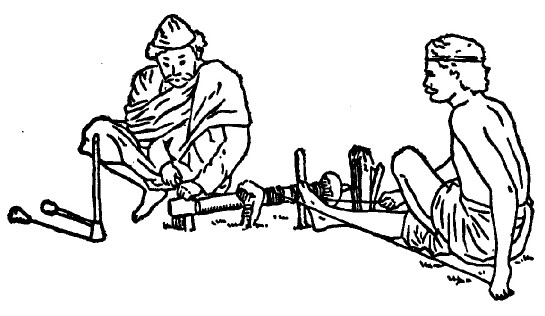Hosted by:

MacGregor Historic Games
Rose & Pentagram Design
2229 East 34th Street, Minneapolis, Minnesota 55407
E-mail
Early Wood Lathes
Ancient Lathes
 Photo Scanned from Burstall's Simple Working Models of Historic Machines
Sketch scanned from Country Furniture, by Aldren A Watson.
Photo Scanned from Burstall's Simple Working Models of Historic Machines
Sketch scanned from Country Furniture, by Aldren A Watson.

The Egyptian lathe is based on a stone carving which may be the earliest pictoral representation of a lathe. Artifacts as early as the 7th century B.C. have been found which appear to have marks consistant with having been turned.
There is some speculation that the Egyptian lathe may actually represent a horizontal set-up, and that it was been portrayed vertically because artists of the time lacked the knowledge of how to represent their subjects with perspective. Although with enough weight on the upper horitcal board, it may well have worked as portrayed with the worker holding the tool and bracing it against the upright
A Indian Lathe based on a similar idea as the Egyptian Lathe above
Scanned from Daumas' A History of Technology & Invention Vol. I.

A diagram of a simple Roman-era bow lathe, showing how the head and tail stocks are buried in the ground to hold the set-up steady. Scanned from Country Furniture, by Aldren A Watson.
 Turning Chess pieces
Turning Chess pieces
from Alphonso X's "Book of Games," Circa 1280 A.D. As with the Egyption stone carving it is believed that this was actually a horizontal set-up. There is no tool rest so the turner is steadying his tool between his toes. There are similar simple lathe that are operated in the same manner which can be seen in third world countries to this day.
Turning Backgammon pieces
Another image from Alphonso X's "Book of Games," showing a man turning Backgammon pieces.

 Photo Scanned from Burstall's Simple Working Models of Historic Machines
Sketch scanned from Country Furniture, by Aldren A Watson.
Photo Scanned from Burstall's Simple Working Models of Historic Machines
Sketch scanned from Country Furniture, by Aldren A Watson.



